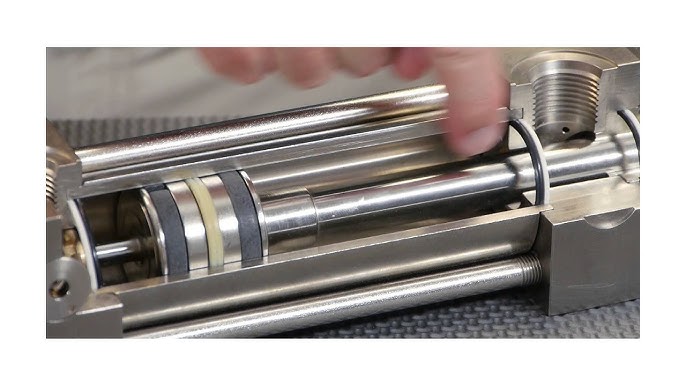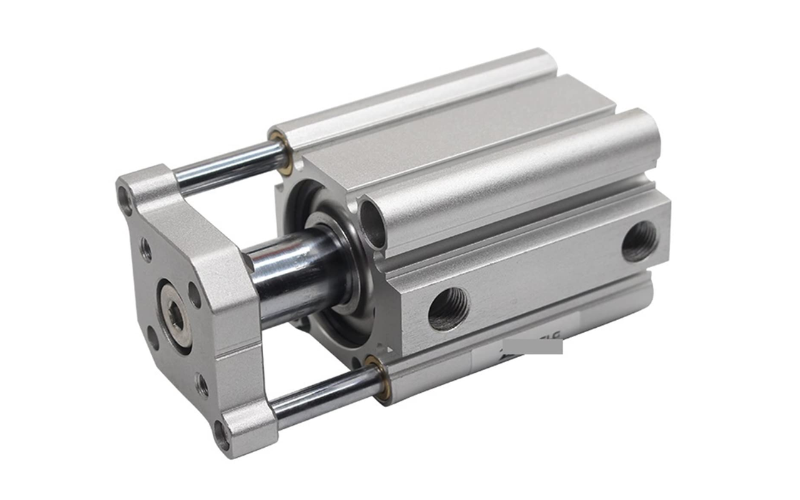The conventional air-operated actuator cylinder uses a piston and rod assembly to move the load. But it can also be without a rod. The rodless pneumatic cylinder operates on a different working principle, offering several advantages over the rodded type. Here, we discuss its operation, the various versions of the device, and more.
What is a Rodless Cylinder?
A rodless cylinder in pneumatics is an unconventional actuator barrel that uses no rod. Instead, the piston moves inside the assembly independently, with a carriage to connect it to the load.
The non-rodded design offers a smaller actuator size. This design makes it great if your application has space limitations or needs the actuator to produce the same force in the forward and reverse strokes.
So, how does a rodless cylinder work, and what are the benefits of its design and operation? In the following section, we delve into the workings of these devices.

Resource: https://www.youtube.com/watch?v=R-OBtVCPjMc
How Does a Rodless Pneumatic Cylinder Work?
It uses air to move a piston forward and backward. That, in turn, drives the load as needed. To better understand the rodless air cylinder, how it works, and other vital aspects, it’s essential to know the parts that make it or its construction.
Rodless Pneumatic Cylinder Parts
The main parts of a typical no-rodded actuator barrel are the piston, carriage, inner and outer bands (slotted type), and end caps.
- Piston – the piston is inside the barrel. It connects to the carrier that’s outside of the assembly. During operation and under air pressure, it moves the carriage to and fro.
- Carrier- this is the part that supports and moves the load. It connects to the piston and carries the load when compressed air enters the tube.
- Inner and Outer Metal Bands – they support and guide the carriage. They also seal the connection between itself and the barrel to prevent fluid leaks.
- End Caps – act as covers and contain adjustable air cushions to help prevent the piston from making hard stops at the end of strokes.
Rodless Pneumatic Cylinder Working Principle
Compressed air or air under pressure enters the tube via an inlet port, pushing the piston. The piston connects to an external carriage. The carriage, in turn, moves the required load.
For the reverse stroke, a control valve introduces compressed air into the opposite side of the piston. The resulting force moves the piston backward, and the carriage moves along.
Note that the force remains constant in either motion direction. The devices working and stroke force depends on several factors:

Resource: https://www.fluidpowerworld.com
Type of Rodless Pneumatic Cylinders
Rodless air cylinders exist in three types: magnetically coupled, cable-asked, and slotted. They differ in the method used to connect the piston assembly to the load-bearing carriage. Below is more about their design differences.
Rodless Cable Cylinder
This type was the earliest version and is still in use today. A cable goes around a pulley and connects to the piston on either end. During operation, the moving piston pulls the cabling, moving a yoke.
These cylinders simplify the overall device design and working principle. However, as cables inevitably wear over time, they thin out and subject the assembly to leaks.
Magnetically Coupled Rodless Cylinder
The magnetic rodless cylinder uses a magnetic field between the load carrier and the piston. The magnet keeps the load carrier in place, pressed against the barrel assembly, and creates a leak-free seal.
However, this design is prone to piston carriage separation and load rotation despite the air-tight connection. The load it can move is also lower, making it only suitable for lighter tasks.
Slotted Rodless Cylinder
The slotted design is the most popular type; it is versatile and has many other benefits, such as longer strokes and a powerful motion. It features a slot in the barrel to connect it to the carriage.
An inner and outer metal band provides the required seal and guides the carriage. The tube assembly/load carrier connection is mechanical and less susceptible to failure and other issues.

Resource: https://www.assemblymag.com
Rodless Air Cylinder Advantages and Disadvantages
A rodless air cylinder offers various benefits, making it a typical and preferred device in many machine systems and automation equipment. Despite that, some features can make it a less suitable choice depending on the application’s needs. Let’s start with the benefits.
Advantages
- The force is equal and constant in forward and reverse directions
- It has a smaller design, making it ideal for use in tight spaces
- There’s no risk of a bending rod during its operation
- The stroke is longer than that of a rodded barrel of the same size
- Powerful movement suitable for higher force applications
Disadvantages
- With no rod extension, the device length determines the load movement.
- The design increases the risk of dust and other materials entering the barrel.
- Prone to air leaks and loss of fluid pressure and force
- Wear of the inner and outer sealing band over time

Resource: https://www.assemblymag.com
Applications of Rodless Pneumatic Cylinder
As mentioned earlier, the rodless air cylinder is prevalent in many industries owing to its powerful and constant force, among other advantages. Examples of uses include those listed below.
- In packaging machinery to move or position and place products
- For lifting loads in storage facilities
- In automotive manufacturing to complete various tasks
- In robotic systems that rely on motion to move various tools
- For various product manufacturing processes that require automated systems
- Incorporated in optical sorting systems to pick and remove unwanted parts
- To cut things in printing presses and similar systems
The list of these uses is almost endless. You can use the device virtually anywhere, including automated and automated systems.
Conclusion
The rodless pneumatics cylinder is one of the most used devices in the automation industry. With a higher reliability level, longer strokes, powerful motion, and greater versatility, it fits a wide range of uses. Understanding how it works should help you decide if it suits your project and take advantage of its many benefits.

